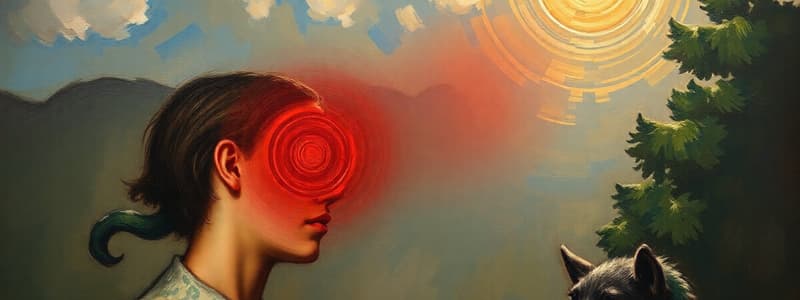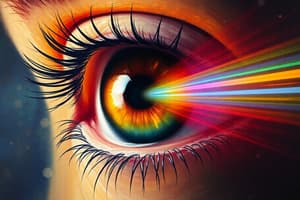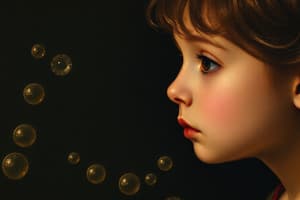Podcast
Questions and Answers
Which of the following accurately describes the relationship between sensation and perception?
Which of the following accurately describes the relationship between sensation and perception?
- Sensation interprets sensory data, while perception involves the initial detection of stimuli.
- Sensation involves the initial detection of stimuli, while perception organizes sensations into meaningful patterns. (correct)
- Perception precedes sensation, providing a framework for detecting stimuli.
- Sensation and perception are interchangeable terms describing the same process.
A person who has difficulty distinguishing between red and green would most likely be diagnosed with which of the following vision problems?
A person who has difficulty distinguishing between red and green would most likely be diagnosed with which of the following vision problems?
- Dark Adaptation
- Conductive Hearing Loss
- Color Blindness
- Color Weakness (correct)
Exposure to excessively loud sounds can result in damage to hair cells, leading to which specific type of hearing loss?
Exposure to excessively loud sounds can result in damage to hair cells, leading to which specific type of hearing loss?
- Noise-Induced Hearing Loss (correct)
- Conductive Hearing Loss
- Tinnitus
- Sensorineural Hearing Loss
Which of the following senses is responsible for providing information about body position, movement, and orientation in space?
Which of the following senses is responsible for providing information about body position, movement, and orientation in space?
What is the primary function of olfactory receptor cells?
What is the primary function of olfactory receptor cells?
Which of the following senses relies on receptors located in the inner ear to maintain balance, detect gravity, and sense acceleration?
Which of the following senses relies on receptors located in the inner ear to maintain balance, detect gravity, and sense acceleration?
A chef walking into a cold storage room struggles to see initially. Which sensory process is he experiencing?
A chef walking into a cold storage room struggles to see initially. Which sensory process is he experiencing?
After a stroke, a patient has difficulty sensing the position of her limbs. Which sensory system has most likely been affected?
After a stroke, a patient has difficulty sensing the position of her limbs. Which sensory system has most likely been affected?
Flashcards
Sensation
Sensation
The process of translating stimuli into electrochemical signals the brain can understand.
Perception
Perception
The mental process of organizing sensations into meaningful patterns.
Color Blindness
Color Blindness
Inability to perceive all or some colors.
Dark Adaption
Dark Adaption
Signup and view all the flashcards
Conductive Hearing Loss
Conductive Hearing Loss
Signup and view all the flashcards
Sensorineural Hearing Loss
Sensorineural Hearing Loss
Signup and view all the flashcards
Kinesthetic Senses
Kinesthetic Senses
Signup and view all the flashcards
Olfaction
Olfaction
Signup and view all the flashcards
Study Notes
Sensory and Perception
- Senses translate what is seen, felt, heard, tasted, and smelled into a form the brain understands via electrochemical signals.
- Sensing the world is the first step in perceiving the world.
- Perception is the mental process of organizing sensations into meaningful patterns.
- Perception occurs when the information arrives at the brain.
Vision Problems
- Color Blindness refers to the inability to perceive color.
- Color Weakness refers to the inability to distinguish certain colors.
- Dark Adaptation refers to increased light sensitivity of the eye under low light conditions, such as temporary blindness when moving from a bright room to a dark room.
Hearing Loss
- Conductive hearing loss involves poor sound transfer from the eardrum to the inner ear.
- Sensorineural hearing loss involves loss of hearing caused by damage to the inner ear.
- Noise-induced hearing loss involves sensorineural loss caused by damaged hair cells from exposure to excessively loud sounds.
Touch
- Somatic senses are related to touch.
- Kinesthetic senses use receptors that detect body position and movement and are located in the muscles and joints.
- Proprioception refers to an awareness of the position and movement of body parts using sensory organs.
- Vestibular senses use receptors that provide coordination in movement and are located in the inner ear.
- Vestibular senses relate to balance, gravity, and acceleration.
Smell and Taste
- Olfaction refers to the sense of smell using olfactory receptor cells.
- Gustation refers to the sense of taste using taste buds, which are clusters of taster receptor cells.
Studying That Suits You
Use AI to generate personalized quizzes and flashcards to suit your learning preferences.
Description
Senses convert stimuli into signals for the brain. Sensing is the first step, followed by perception, the organization of sensations. Common vision issues include color blindness and dark adaptation. Hearing loss can be conductive, sensorineural, or noise-induced.




